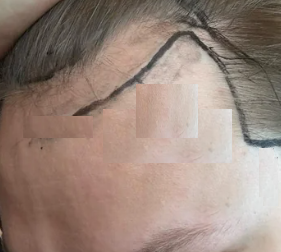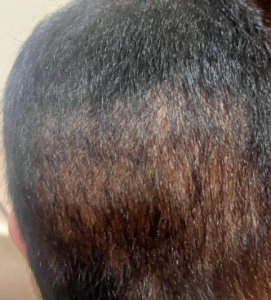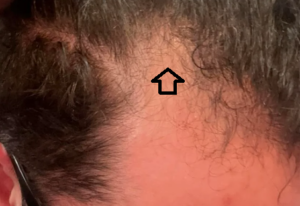Hello, I had a complete reversal of my hair loss with minoxidil and finasteride. According to your clinical experience, would stopping the finasteride cause a loss in my benefits?
If you have achieved your goals on both minoxidil and finasteride, you risk losing the effects by stopping both, as you can’t judge which drug was responsible for your benefits without stopping one and paying the price of hair loss to find out.
[If you have any questions, you can reach me at williamrassman33@gmail.com]
I messed up and scratched while sleeping on my second night after the surgery. I’ve had a real problem with this, and this time I paid the price and lost a hair in my hairline. It seems to only be one graft, luckily. I’m actually going to stay awake for the rest of the night and find a way to strap my arms to my sides tomorrow.
Get a pair of mittens and put them on at night. That is what I have advised others like you who can’t stop scratching. Some men continue to scratch their recipient sites after days or weeks. Scratching will cause folliculitis and the result is in the loss of the transplants if not treated.
[If you have any questions, you can reach me at williamrassman33@gmail.com]
This man has a heavy distribution of hair on his body. Fortunately, he has no balding at this time. Can this man use all of this hair for hair transplants?
The hair thickness of body hair is about 20-25 microns, while the hair of the scalp ranges from fine (25-45 microns), medium 45-60 (microns), and Coarse (greater than 60 microns), so the value of each hair transplanted (usually a single hair in each graft) is generally poor from a coverage point of view. Worse yet, these body hairs have a long telogen cycle and a relatively short anagen cycle. Let’s assume that the anagen and telogen cycles are equal (reasonable), meaning that 50% of the time, the hairs will have fallen out and not reappear until the anagen cycle kicks in for the duration of the hair cycle. The entire body hair cycle ranges from approximately 6-10 months. So if a surgeon were to transplant 1000 of these very thin 25-micron hairs, then only 500 would appear at any time. Most surgeons charge by the grafts, and as most of these would be single hair grafts, the value of each graft based on the number of grafts growing would be reduced by 50% (based upon the hair cycle) and further reduced when compared to the scalp donor hair because that average # of hairs in the scalp average 2+ hairs each. That would further reduce the value per dollar spent. In addition, the body hair thickness is so ‘fine’ (25 microns) that it would take a lot of these body hairs to significantly impact a hair transplant recipient area. I am NOT a big fan of body hair as a donor source for a hair transplant for the above reasons.
| Comparing scalp and body hair’s value to what you see after transplant grows | Average Caucasian | Man in photo below |
| Hairs per graft | 1 | 2+ |
| Hair thickness | 25 microns | 25-90 microns |
| Avaibility of hair to show(cycle) | 50% of the time | 95%+ |
| Quality of hair | Looks like body hair | Looks like scalp hair |
| Value compared to Scalp Hair | Ranges downward from 25% and less | 100% |
[If you have any questions, you can reach me at williamrassman33@gmail.com]
The clinic recommended 3200 grafts for this hairline fix.
If your hair is fine, 3200 grafts might be reasonable; however, if your hair thickness is medium or coarse, 3200 grafts are far too many for this small area. Remember, 3200 grafts likely reflect almost half of your overall supply, so you might need more than the amount of hair remaining if you develop significant balding in the future. What does your family pattern look like with men in the family line in their 40s, 50s, and 60s? This is an essential factor for you to consider. I hope you are over 26 years old now and know your present balding pattern and your surgeon discussed your lifetime hair supply as well as your worst case balding pattern with you. BTW, your temple peaks are fine and should not be transplanted.
How do I find a good SMP provider? What could go wrong? I want to understand the risks and what to look out for. I tried to cover it with longer hair but it shows through.
Things can go wrong with the wrong operator. These include 1) the wrong inks, 2) an operator that doesn’t have the skills to make small dots Be sure to ask the operator who does the SMP to meet with a couple of patients, and when you see them, look closely. What you see is what you are likely going to get.
So I started FIN when I was 19 (28 now). My system took to it well and the balding/hairline hasn’t gotten worse since. However my beard hair never became terminal since I started so young. I have pretty decent coverage of beard hair but I can’t grow them out because it looks too soft and fuzzy. I guess that’s the vellus hairs? Is there any chance I can go off FIN for a bit and get those beard hairs to turn terminal? If so how long do you think that could take? Curious if anyone has done something similar. I don’t mind loosing some hair because I have too much anyways. I have naturally very thick coarse hair, to the point where I actually struggle getting good haircuts and it’s been a lifelong struggle to the point where I just wear beanies most of the time anyways.
Concerns: Just want to make sure that I jump back on FIN and can stop any shedding in its tracks again.
Men who don’t get beard growth, blame finasteride as the cause; however, finasteride does not prevent bread growth, it may slow it down, but not prevent it. Treat your beard loss with (1) waiting a few years for more beard development, (2) add minoxidil to your beard area, (3) consider a beard transplant, something offered by many doctors today.
I am 34.5 years old today, I started finasteride and minoxidil on September 16, 2023 and I am experiencing great results after 3-4 months. And so far I see and notice active shedding, and I noticed at the 6 month mark a sort of loss of results. Is this reasonable?
There is a “Tug of war” between your drugs and your genetic hair loss. “Which one wins?” is your question. There is no doubt that finasteride, for example, will always either slow, stop or reverse hair loss. Slowing implies that the hair loss could be ongoing.
I know this is just a weird question, but I’d like to know since I plan to try out microneedling and get back into my morning jogs. I figured I ask since with microneedling you’re pretty much inflicting small incisions, and when working out your blood will be pumped much faster than usual.
If you wait at least 30 minutes after you microneedle, you can probably jog without much problem. Then, go into a shower and wash your scalp along with everything else to be sure that the scalp is clean. By that time, the bleeding should have stopped.
I gained some of my hair back with the help of 5ar inhibitors and minoxidil, but it is not in perfect. So I really want to do hair transplant surgery to get more fuller hair, but the doctors I see keep turning me down. Why is that?
If you got a hair transplant and had a lot of miniaturized hair, what you might lose could equal your hair transplant gain. You could be worse off. That is why I can only tell you a little about your situation, as I need to examine you. When doctors transplant a patient for genetic balding, they like to see PATTERNED hair loss not unpatterned hair loss like you have. Unpatterned hair loss means that the surgeon may not be able to achieve specific goals for specific areas where your problem is worse.
Hello, are pimples normal in donor area? I have Afro hair and I have a few bumbs on my donor area. I’m on day 8 post ht.
Pimples in the donor area may be a reflection of buried hair follicles from the surgery or fragments of hair follicles that are associated with the grafts when they are implanted. There are usually not many of them when the surgery is done by an experienced surgeon but this happens even with the best surgical teams. See your doctor
You are receiving a cumulative dosing of 0.25mgs/day, which, according to Merck’s study, is 50% as effective as the 1mg dose. If I were you, I would increase it to daily use if that works for you. That gets you 100% effectiveness for this drug.
Page 16 of 634










